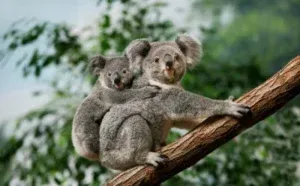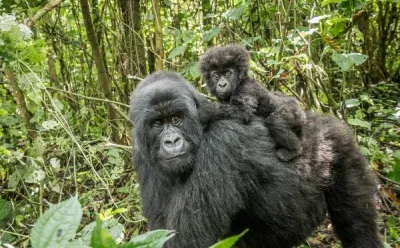ecowarriornation.com. What Animals are Affected by Climate Change? – Discover the shocking truth about what animals are being affected by climate change. Explore the key species at risk and understand the ecological consequences in this in-depth article.
Climate change is an undeniable reality, and its far-reaching consequences extend well beyond rising temperatures and erratic weather patterns. One of the most alarming aspects of climate change is its impact on the world’s diverse ecosystems and the creatures that inhabit them.
In this comprehensive article, we will delve into the question: “What animals are affected by climate change?” and explore the species most vulnerable to these environmental shifts. From polar bears in the Arctic to coral reefs in the oceans, no corner of the Earth’s biosphere remains untouched by the forces of climate change.
Table of Contents
ToggleWhat Animals are Affected by Climate Change
1. Polar Bears
Polar bears, often referred to as the charismatic icons of climate change, exemplify the profound challenges that wildlife face in a warming world. These magnificent creatures are supremely adapted to life in the harsh Arctic environment, where they depend on the vast expanses of sea ice to hunt seals, their primary source of sustenance. However, the relentless march of climate change, characterized by rising temperatures and the rapid decline of Arctic sea ice, has cast a dark shadow over the future of polar bears.
Sea Ice Retreat
One of the most visible and immediate consequences of climate change for polar bears is the retreat of sea ice. The Arctic sea ice serves as a crucial platform for polar bears to hunt seals, their primary prey. From these icy platforms, polar bears can stealthily approach breathing holes in the ice and pounce on unsuspecting seals. This hunting strategy is a testament to their remarkable adaptations for a frigid, icy world.
However, the Arctic is warming at twice the rate of the global average, and this heightened warming is causing the sea ice to recede at an alarming rate. As a result, polar bears are forced to swim longer distances between ice floes in search of seals, expending more energy and finding it increasingly challenging to secure their meals. The lack of sea ice also means that polar bears have fewer resting platforms, which further strains their energy reserves.
Starvation and Reproductive Challenges
The impact of reduced sea ice is most acutely felt during the critical feeding season. Pregnant female polar bears, in particular, depend on this period to build up their fat reserves, which they rely upon to survive during the leaner months and to give birth and nurse their cubs in winter dens. As sea ice diminishes, these females are struggling to gain the necessary weight, leading to reduced cub survival rates and the overall decline in the polar bear population.
Encroachment of Human Activity
The impacts of climate change are further compounded by human activities in the Arctic, including shipping, oil and gas exploration, and tourism. As the ice melts and Arctic waters become more navigable, polar bears face increased interactions with humans, which can lead to additional stress and disturbances.
Conservation Efforts
Efforts to conserve polar bears are multifaceted. The most critical action is mitigating climate change itself by reducing greenhouse gas emissions. Additionally, various conservation measures are being implemented to protect polar bear habitat, reduce human-bear conflicts, and study and monitor the bear populations.
In conclusion, polar bears, majestic symbols of the Arctic, are at the forefront of the impacts of climate change. Their very survival is contingent on our ability to address the root causes of climate change and reduce our carbon footprint.
Preserving their icy habitat is not just about protecting one species; it’s about safeguarding an entire ecosystem and acknowledging the interconnectedness of life on our planet. The story of the polar bear serves as a stark reminder of the urgency with which we must act to combat climate change and protect the precious biodiversity of our world.
2. Koalas
Koalas, often associated with the unique wildlife of Australia, are adorable marsupials that have become emblematic of the challenges faced by countless species in the era of climate change. Climate change is a global phenomenon, but its impact on these iconic animals is felt acutely in the vast eucalyptus forests they call home.

Heatwaves and Habitat Loss
Koalas are particularly sensitive to the effects of climate change, which has led to increased frequency and intensity of heatwaves in many parts of their habitat. These heatwaves can cause dehydration and heat stress in koalas, making them vulnerable to disease and increasing their mortality rates. The reduced availability of water sources during heatwaves further compounds this challenge.
Moreover, climate change has contributed to the increased frequency and severity of wildfires in Australia, which pose a significant threat to koalas. These bushfires, fueled by drier conditions and extreme temperatures, have led to widespread habitat destruction and loss of life among koalas and other native wildlife.
Limited Adaptability
Koalas have evolved to be highly specialized in their diet, primarily feeding on eucalyptus leaves. However, the leaves of these trees have low nutritional value, which means koalas must consume a substantial quantity to meet their daily energy requirements. As climate change alters the nutritional content of eucalyptus leaves and increases water stress in these trees, koalas find it even more challenging to secure sufficient nourishment.
Threats to Genetic Diversity
Koala populations are further threatened by habitat fragmentation and the loss of genetic diversity. Fragmentation makes it difficult for populations to interbreed, which can lead to inbreeding and the expression of harmful genetic mutations. The combination of climate change and habitat fragmentation can reduce the adaptability of koalas to changing conditions.
Conservation Efforts
Efforts to conserve koalas involve a range of strategies, from habitat protection and restoration to translocation programs aimed at relocating koalas from high-risk areas to safer regions. Additionally, research is ongoing to better understand koala behavior, genetics, and physiology in the context of a changing climate.
Koalas, with their enchanting appearance and unique ecological role, are under substantial threat due to climate change. Their story highlights the broader challenges faced by countless species worldwide, particularly those that are highly specialized and adapted to specific ecological niches.
As we seek to protect koalas and their habitats, we are reminded that climate change’s impact extends well beyond rising temperatures—it encompasses alterations to ecosystems and challenges to the survival of species, necessitating global cooperation and concerted action to address the root causes of climate change. The plight of the koala should serve as a call to action to protect these beloved marsupials and the biodiversity of our planet.
3. Corals
Coral reefs, despite not being animals themselves, are intricate ecosystems comprised of thousands of coral polyps, algae, and a diverse array of marine life. They are among the most sensitive and severely affected by climate change. As the oceans warm and become more acidic due to rising carbon dioxide levels, coral reefs are experiencing devastating consequences.
Coral Bleaching
Coral bleaching is one of the most visible and alarming impacts of climate change on these vibrant ecosystems. Corals have a mutually beneficial relationship with tiny photosynthetic algae called zooxanthellae.
The corals provide shelter and nutrients to the algae, while the algae supply the corals with energy through photosynthesis. However, when ocean temperatures rise, corals expel these vital algae, leading to coral bleaching.
Bleached corals lose their vibrant colors and become vulnerable to disease and death. While some corals can recover if water temperatures return to normal, prolonged or frequent bleaching events can be catastrophic, leaving vast stretches of reefs degraded or destroyed.
Ocean Acidification
Another significant threat to corals is ocean acidification. As the oceans absorb excess carbon dioxide from the atmosphere, the water becomes more acidic. This increased acidity makes it challenging for corals to build their calcium carbonate skeletons, which are the foundation of coral reefs. Weakened and brittle corals are less resilient and more susceptible to physical damage from storms and other disturbances.
Impact on Marine Biodiversity
Coral reefs are not only the rainforests of the oceans but also crucial nurseries and habitats for numerous marine species. As the health of coral reefs declines due to climate change, this has a ripple effect on the entire marine ecosystem. Fish, mollusks, and other creatures that rely on the reef for shelter and food are also at risk, leading to declines in fishery yields and biodiversity loss.
Conservation and Restoration
Efforts to protect coral reefs include the establishment of marine protected areas, sustainable fishing practices, and monitoring programs to assess the health of coral ecosystems. Coral restoration initiatives, such as coral farming and transplanting, aim to rebuild damaged reefs and improve their resilience to climate change.
International Cooperation
Given the transnational nature of oceans and climate change, protecting coral reefs requires international collaboration to reduce carbon emissions and mitigate the root causes of climate change. The Paris Agreement, which focuses on limiting global warming, is one such international effort to address the issues that affect coral reefs.
In conclusion, coral reefs, despite being composed of tiny organisms, play an outsized role in marine ecosystems and provide essential services to both marine life and coastal communities.
The devastating impacts of climate change on corals are a stark reminder that global warming and carbon emissions have far-reaching ecological consequences. Protecting these unique ecosystems necessitates collective action to address the root causes of climate change and safeguard the world’s oceans for future generations. The fate of corals is intertwined with the broader health of our planet’s ecosystems, making their preservation a global imperative.
4. Penguins
Penguins, often celebrated for their charming appearance and distinctive waddle, are a group of birds that have adapted to thrive in some of the most extreme environments on Earth.
They are highly specialized for life in the frigid, aquatic worlds of the Southern Hemisphere, particularly in the Antarctic and sub-Antarctic regions. However, these remarkable birds are facing significant challenges due to the impacts of climate change.
Vanishing Sea Ice
Penguins, such as the iconic Emperor penguins, Adélie penguins, and many other species, are highly dependent on sea ice. Sea ice serves as a critical platform for their activities, including breeding, molting, and, most importantly, foraging.
These birds are skilled hunters in the icy waters, preying on krill and fish. However, rising temperatures are causing the rapid retreat of sea ice in their habitats, making it more difficult for them to access their food sources.
Altered Food Availability
The loss of sea ice doesn’t only mean less space for penguins; it also has significant consequences for their prey species. Krill, a tiny crustacean that forms a substantial part of the penguin diet, depends on sea ice for their life cycle.
The retreat of sea ice disrupts the availability and distribution of krill, forcing penguins to travel greater distances to find food. This increased effort can lead to higher energy expenditures and lower reproductive success.
Breeding Challenges
Many penguin species breed in colonies on the coastal areas of the Antarctic and its surrounding islands. These areas are also vulnerable to the impacts of climate change. Increased storm activity, resulting from changing weather patterns, can flood nests and lead to higher chick mortality rates. As warming temperatures affect the delicate balance of ecosystems, penguins may face food scarcity during critical breeding seasons, reducing chick survival rates.
Competition with Other Predators
Changing environmental conditions may bring new challenges to penguins in the form of increased competition with other predators. As food becomes scarcer, various species, including other birds and marine mammals, might vie for the same limited resources. This heightened competition can threaten the penguins’ ability to secure enough food to sustain themselves and their chicks.
Conservation Efforts
Conservation initiatives for penguins encompass a variety of strategies. These include the establishment of marine protected areas, tracking penguin populations and movements, and supporting scientific research to better understand the challenges they face. Researchers are also studying the impacts of climate change on penguin colonies to develop strategies for their conservation.
In conclusion, penguins, with their unique adaptations for life in the Southern Hemisphere, exemplify the wide-ranging effects of climate change on wildlife. As their icy habitats transform and prey availability becomes unpredictable, penguins face significant challenges in their struggle for survival.
Addressing these challenges involves not only protecting their habitats but also mitigating the root causes of climate change. The story of penguins is a stark reminder that the consequences of climate change extend well beyond temperature increases, affecting even the most resilient and charismatic of Earth’s inhabitants. It underscores the importance of global efforts to combat climate change and protect the diverse ecosystems that make our planet so extraordinary.
5. Migratory Birds
Migratory birds represent some of the most remarkable feats of nature. These avian adventurers crisscross the globe, traveling thousands of miles between their breeding and wintering grounds in search of suitable habitats and resources.
Their journeys are orchestrated with remarkable precision, timed to coincide with changing seasons and the availability of food. However, climate change is altering the landscapes and conditions these birds rely on, and they are facing increasing challenges during their annual migrations.
Changing Seasonal Cues
Migratory birds rely on environmental cues, such as day length and temperature changes, to signal the timing of their migration. Climate change is disrupting these cues, leading to discrepancies between when birds depart and when they arrive at their destinations. This timing mismatch can have cascading effects on their ability to secure nesting sites and sufficient food for themselves and their chicks.
Habitat Loss
One of the primary challenges migratory birds face is the loss of critical stopover and breeding habitats. As human development and land-use changes continue, natural areas where birds rest and refuel during their migrations are vanishing. These stopover sites are essential for providing the birds with the necessary energy to continue their journeys.
Extreme Weather Events
Climate change is associated with an increase in extreme weather events, such as hurricanes and storms. These events can prove deadly for migratory birds during migration, particularly when they are caught in the path of a severe storm. Habitat destruction and food scarcity in the aftermath of these events can be especially damaging to their populations.
Altered Food Availability
Migratory birds, particularly insect-eating species, depend on the availability of insects in their breeding areas. However, changes in temperature and altered weather patterns can affect the timing and abundance of insects, making it more challenging for birds to find sufficient food for themselves and their young.
Range Shifts
Some migratory birds are also experiencing shifts in their breeding and wintering ranges. As temperatures warm, some species are breeding farther north than before, while others are wintering in different regions. These shifts can lead to increased competition for limited resources and potential conflicts with local wildlife.
Conservation Efforts
Efforts to protect migratory birds often involve creating and preserving critical habitats, particularly stopover sites. This requires international cooperation because migratory birds cross multiple countries during their journeys.
Conservation organizations and researchers are working together to track the movements of migratory birds, identify their most critical habitats, and implement protective measures.
In conclusion, the remarkable journeys of migratory birds are at risk due to the profound effects of climate change. Disrupted cues, habitat loss, extreme weather, and altered food availability are all challenges that these species face during their migrations.
Their stories emphasize the importance of global conservation efforts and international cooperation to address the root causes of climate change and protect the habitats essential for the survival of these avian travelers. The fate of migratory birds is a barometer of the broader challenges faced by wildlife in an era of environmental change and underscores the urgency of action to mitigate the impacts of climate change.
6. Butterflies
The delicate balance of butterfly populations is being disrupted as climate change affects the plants they depend on for nectar. Changes in temperature and precipitation patterns can impact their reproductive cycles and migration patterns.
Butterflies, with their delicate and vibrant wings, are among the most enchanting and beloved creatures in the natural world. They serve as essential pollinators for many plant species and play a vital role in maintaining the health and diversity of ecosystems. However, these fragile insects are not immune to the impacts of climate change, which are affecting their behavior, distribution, and survival in various ways.
Phenological Shifts
One of the most noticeable effects of climate change on butterflies is the alteration of their life cycles. Warmer temperatures are causing butterflies to emerge from their pupae, or chrysalises, earlier in the year. This phenological shift can lead to mismatches between the emergence of butterflies and the availability of their preferred nectar sources or host plants. This, in turn, can disrupt their reproductive cycles and migration patterns.
Habitat Loss
Climate change contributes to habitat loss and degradation, affecting the plants that butterflies rely on for food and reproduction. Butterflies have specific host plants upon which they lay their eggs, and these plants are intricately connected to local climate and soil conditions. Changes in these conditions can reduce the availability of host plants, jeopardizing butterfly populations.
Range Shifts
As temperatures rise, many butterfly species are expanding their ranges to cooler areas. While this can lead to increased opportunities for some species, it can also result in greater competition with resident butterfly species and an increased risk of predation. Additionally, the dispersal of butterflies can affect the availability of pollinators for plants that depend on them.
Stress on Overwintering
Butterflies in temperate regions often overwinter as pupae, caterpillars, or adults. These overwintering strategies are sensitive to temperature changes. Milder winters can lead to premature emergence from hibernation, which can result in higher mortality rates, especially if a cold snap follows an early emergence.
Habitat Fragmentation
Climate change also exacerbates habitat fragmentation, as natural areas are lost or fragmented due to human development. For butterflies, fragmented habitats can make it challenging to find suitable breeding and nectar sources, making their populations more vulnerable.
Conservation Efforts
Efforts to protect butterflies often involve the preservation and restoration of their habitats. This includes planting native host plants and nectar sources in gardens and protected areas, as well as maintaining and creating butterfly-friendly landscapes. Furthermore, citizen science initiatives help track butterfly populations and their phenology, contributing to a better understanding of their responses to climate change.
7. Mountain Gorillas
These gentle giants inhabit the high-altitude forests of Africa. With rising temperatures, diseases that were once confined to lower elevations are creeping into their habitat, posing a severe threat to their already endangered populations.

Mountain gorillas are among the most iconic and charismatic species of primates, known for their gentle nature and familial bonds. These remarkable creatures live in the dense forests of the African mountains, in regions such as the Virunga Mountains and Bwindi Impenetrable Forest. Unfortunately, the survival of mountain gorillas is imperiled by several climate change-related factors.
Disease Incursion
One of the significant threats facing mountain gorillas due to climate change is the encroachment of diseases into their habitat. Warming temperatures can alter the range and behavior of disease vectors such as mosquitoes and ticks. These vectors can transmit diseases like malaria and Ebola, which were once confined to lower altitudes. Mountain gorillas have little natural immunity to these diseases, and their populations are at risk as a result.
Habitat Alteration
Rising temperatures and changes in precipitation patterns can have far-reaching effects on the mountain gorillas’ forest habitat. These changes can lead to alterations in the availability of food sources, such as bamboo shoots and other vegetation, which are critical to the gorillas’ diet. Furthermore, shifts in vegetation can affect the distribution and behavior of the gorillas and their potential exposure to predators.
Human-Wildlife Conflict
The increasing frequency and intensity of extreme weather events, such as storms and droughts, can drive mountain gorillas into human-occupied areas in search of food. This can lead to human-wildlife conflict, endangering both the gorillas and local communities. Climate change exacerbates this conflict by disrupting the availability of food resources in the gorillas’ natural habitat.
Conservation Efforts
Efforts to protect mountain gorillas include conserving their habitat through the establishment of protected areas and enhancing anti-poaching measures to safeguard their populations. Gorilla tourism, when managed sustainably, can provide vital funding for conservation efforts and support for local communities. Research and monitoring are also essential to understand the impacts of climate change on mountain gorillas and develop strategies to mitigate its effects.
Climate Change Mitigation
Addressing the threats of climate change to mountain gorillas involves broader climate change mitigation efforts, including the reduction of greenhouse gas emissions. This requires international cooperation to slow the rate of global warming and limit the spread of disease vectors and the disruption of mountain ecosystems.
In conclusion, mountain gorillas, with their complex social structures and unique ecosystems, are at risk due to climate change-related factors. Disease encroachment, habitat alteration, and human-wildlife conflict pose significant challenges to their populations.
Their conservation is a testament to the interconnectedness of all species within ecosystems and the importance of climate change mitigation. Protecting mountain gorillas is not only vital for their survival but also for preserving the rich biodiversity and ecological integrity of the African mountains they call home.
8. Salmon
Warmer water temperatures can affect salmon’s ability to migrate and spawn. This has consequences not only for salmon populations but also for the predators and human communities that depend on them.
Salmon are an iconic species of fish that hold immense ecological, economic, and cultural significance in various parts of the world, particularly in North America and Northern Europe. These remarkable fish are known for their epic migrations from freshwater rivers to the open ocean and back again to spawn in their natal streams. However, the complex life cycle of salmon is increasingly threatened by climate change.
Warming Waters
One of the most significant challenges salmon face due to climate change is the warming of their freshwater and marine habitats. Warmer water temperatures can affect salmon at various life stages. In rivers, warmer waters can decrease the survival rates of salmon eggs and fry, particularly during critical developmental stages. In the ocean, higher temperatures can disrupt the distribution of prey species, reducing food availability for adult salmon.
Altered Migration Timing
Salmon rely on the precise timing of their migrations to ensure their survival and reproduction. Changes in climate can affect the timing of key events, such as the emergence of aquatic insects that juvenile salmon feed on. These timing mismatches can lead to reduced food availability for young salmon and increase their vulnerability to predation.
Habitat Loss and Drought
Climate change contributes to habitat loss and degradation through various mechanisms, such as deforestation, land development, and increased droughts. These factors can result in shallower rivers and decreased flow, which can impede the passage of salmon to their spawning grounds. Low water levels can also lead to increased water temperatures, which are harmful to salmon eggs and juvenile fish.
Ocean Acidification
Ocean acidification, caused by the absorption of excess carbon dioxide by the oceans, can have indirect but substantial impacts on salmon. Acidic waters can reduce the availability of calcium carbonate, which affects the base of the marine food web. As a result, the abundance of plankton and prey species for salmon can decrease, affecting their food supply.
Conservation Efforts
Conservation initiatives for salmon involve protecting and restoring their freshwater and marine habitats. This includes efforts to reduce habitat degradation, maintain water quality, and mitigate the impacts of climate change. Fisheries management is essential to regulate harvest levels and protect wild salmon populations. Additionally, hatchery and supplementation programs aim to bolster declining salmon populations.
Climate Change Mitigation
Addressing the threats of climate change to salmon requires broader climate change mitigation efforts, such as reducing greenhouse gas emissions to limit the extent of warming in both freshwater and marine environments. Sustainable land use and habitat protection can also contribute to the resilience of salmon populations in the face of changing climate conditions.
What Animals are Being Affected by Climate Change
- Sea Turtles
Rising sea levels and increasing temperatures are threatening the nesting sites of sea turtles. Their hatchlings, which rely on temperature-dependent sex determination, face challenges as temperatures become more unpredictable.
- Cheetahs
Climate change is altering the distribution of prey species for cheetahs, making it harder for them to find food. Additionally, the increased competition with other predators further jeopardizes their survival.
- Moose
These large herbivores are suffering from the expansion of disease-carrying ticks in warmer climates. Heat stress and habitat loss are also contributing to their decline.
- Sharks
Changes in ocean temperatures affect the distribution of prey species and disrupt the delicate balance of marine ecosystems, which in turn threatens various shark species.
- Reindeer
The Arctic’s rapidly warming climate is affecting the reindeer’s primary food source, lichen. This, in turn, endangers the indigenous communities that rely on reindeer herding.
- Bees
Climate change is causing shifts in the availability of flowering plants, impacting the food sources for bees. Increased heatwaves and habitat loss further threaten their populations.
- Whales
Changing ocean conditions affect the distribution of krill and other primary food sources for whales, putting pressure on these gentle giants.
FAQs
Q1: How does climate change affect animals?
Climate change affects animals by altering their habitats, food sources, and migration patterns. It can lead to extreme weather events, such as heatwaves and storms, which disrupt ecosystems and directly harm wildlife.
Q2: Are humans affected by climate change in the same way as animals?
While humans are also affected by climate change, we have more adaptability and resources to mitigate its impact. However, vulnerable communities, especially in developing countries, may experience the effects of climate change more acutely.
Q3: What can we do to help animals affected by climate change?
Reducing our carbon footprint, conserving natural habitats, and supporting wildlife conservation efforts are essential steps to mitigate the impact of climate change on animals.
Q4: How can we protect polar bears and other threatened species?
Protecting polar bears and other vulnerable species requires international cooperation to reduce greenhouse gas emissions, conserve their habitats, and address the root causes of climate change.
Conclusion
The question of “What animals are affected by climate change” carries a weighty answer. From the North Pole to the Amazon rainforest, countless species are grappling with the adverse effects of a changing climate.
While some may adapt, many will face significant challenges in their struggle for survival. As responsible stewards of the Earth, it is incumbent upon us to address the root causes of climate change, reduce our impact, and actively work to protect these creatures and the ecosystems they call home. The future of our planet depends on it.













